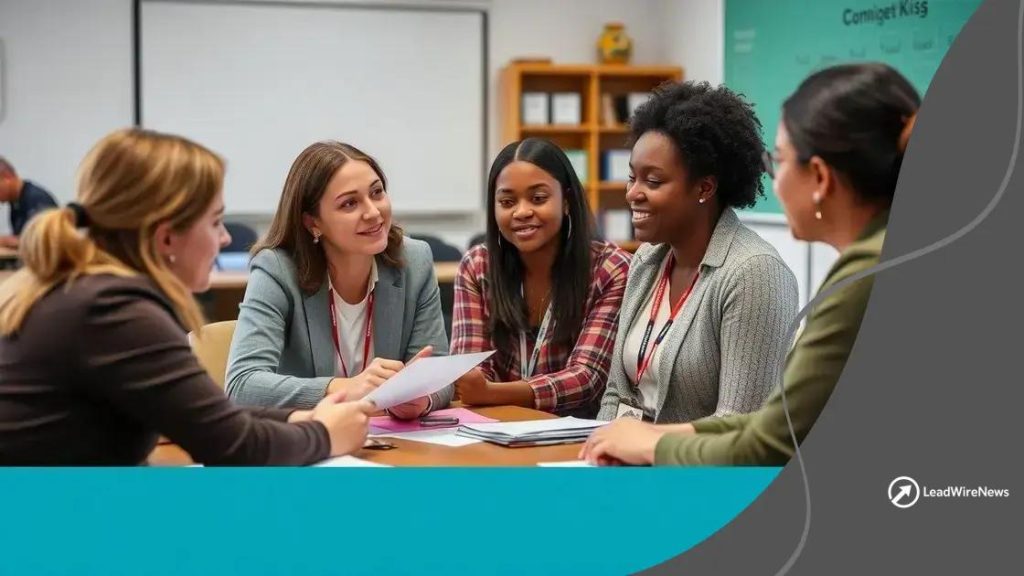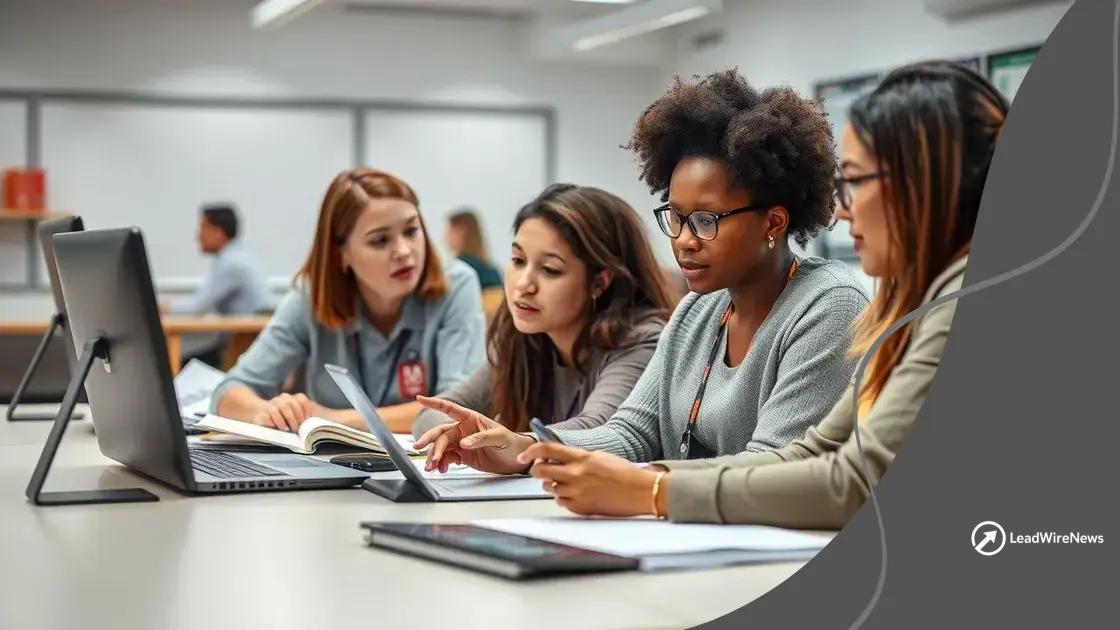Teacher professional development initiatives that inspire growth

Anúncios
Teacher professional development initiatives are essential for enhancing educators’ skills through innovative methodologies, technology integration, and focus on emotional support, ultimately improving student learning outcomes.
Teacher professional development initiatives play a crucial role in enhancing classroom dynamics and teacher effectiveness. Curious about how these programs can make a difference? Let’s dive into the impactful strategies available to educators today.
Anúncios
Understanding the importance of teacher development
Understanding teacher development is essential for fostering an effective learning environment. It empowers educators and enhances the quality of education delivered to students. Let’s explore why this investment is critical.
Benefits of Teacher Development
One of the main benefits of robust teacher development is improved student outcomes. When teachers refine their skills, they offer more engaging lessons. This leads to a positive learning experience for students.
- Enhanced teaching strategies
- Increased job satisfaction
- Stronger student relationships
Additionally, teacher development creates a culture of continuous learning. It encourages educators to stay current with teaching trends and methodologies. Professional workshops and courses provide valuable insights that teachers can apply in their classrooms.
Anúncios
Creating a Supportive Environment
Schools should cultivate a supportive environment for teacher development. This can be achieved through collaborative planning and peer observations. When teachers work together, they learn more effectively.
- Encouragement from administration
- Opportunities for mentorship
- Access to resources and materials
In summary, investing in teacher development yields substantial benefits, from increased teacher effectiveness to improved student engagement. By understanding the importance of continuous growth, schools can create a thriving educational community.
Key components of effective programs
Understanding the key components of effective professional development programs is crucial for achieving impactful results. These elements ensure that programs meet the needs of teachers and enhance their skills.
Comprehensive Needs Assessment
Identifying the specific needs of educators is the first step in creating a successful program. A needs assessment helps uncover gaps in knowledge and skill areas requiring improvement. This allows tailored training that addresses actual classroom challenges.
- Surveys and feedback from teachers
- Classroom observations
- Analysis of student performance data
By basing development on real data, schools can focus on what truly matters to their teachers.
Collaborative Learning Opportunities
Effective programs encourage collaboration among educators. Sharing experiences fosters a sense of community and trust. Teachers can learn from one another’s insights and strategies, which can be incredibly valuable.
- Peer coaching sessions
- Team teaching experiences
- Group planning sessions
Collaboration builds a support system that enhances the overall teaching experience.
Engaging and varied learning formats also enhance fewer monotone sessions and can include workshops, online courses, and hands-on training. Incorporating different styles keeps educators interested and engaged in their own learning. This mix of methods helps to cater to different learning preferences, ensuring that all educators can benefit from the experience.
Ultimately, monitoring and evaluating the program’s effectiveness is vital. Regular feedback mechanisms help ascertain if goals are met, and adaptations can be made as needed for continuous improvement.
Innovative methodologies for professional growth

Innovative methodologies for professional growth are essential in today’s fast-paced educational landscape. These approaches help educators stay engaged while continually enhancing their skills.
Project-Based Learning
Project-based learning (PBL) is a dynamic classroom approach in which students actively explore real-world problems and challenges. This method encourages teachers to design projects that reflect current educational trends and student interests. When teachers engage in PBL themselves, they model this enriching experience for their students.
- Encourages critical thinking
- Promotes collaboration among students
- Develops practical skills relevant to the workplace
Through PBL, teachers can reflect on their practices while empowering students to take responsibility for their learning.
Online Collaborative Platforms
Utilizing online collaborative platforms offers teachers a unique way to communicate and share ideas. These tools allow for real-time interaction, brainstorming, and resource sharing. When educators engage in virtual communities, they break the barriers of geographical location.
- Access to diverse perspectives
- Continuous support from peers
- Resource sharing across various districts
Such collaboration fosters a sense of community and provides valuable insights into successful teaching strategies. The use of technology in these methodologies not only enhances learning but also aligns with 21st-century skills that are critical today.
Participating in workshops that focus on culturally relevant teaching is another innovative way to boost professional growth. This approach emphasizes inclusivity and considers the diverse backgrounds of students. Teachers learn strategies tailored to their unique student populations, which helps create a more engaging and relevant learning environment.
Evaluating the impact on student learning
Evaluating the impact on student learning is a critical aspect of professional development initiatives. When educators invest in their growth, it’s essential to assess how these efforts translate into improved student outcomes.
Data-Driven Assessment
Using data to measure the effects of teacher development programs allows schools to identify what works. Multiple sources can provide insight into student performance, helping to track changes over time.
- Standardized test scores
- Student feedback surveys
- Classroom assessments
By analyzing these results, educators can pinpoint areas of growth and those needing further support.
Observation and Feedback
Observing classroom practices is another way to evaluate progress. Peer observations provide opportunities for constructive feedback, allowing teachers to learn from each other. This method encourages collaboration and insights that can lead to improved teaching methods.
- Structured observation tools
- Regular peer review sessions
- Follow-up discussions for reflection
Additionally, involving students in the evaluation process can provide valuable perspectives. Engaging them in discussions about their learning experiences encourages reflection and highlights areas where teaching methods resonate.
Furthermore, continuous improvement is a central theme in evaluating student learning outcomes. Programs should include a mechanism for feedback that allows educators to adjust their approaches effectively. This flexibility ensures that professional development remains relevant and impactful for both teachers and students. The focus should always be on enhancing the educational experience, which ultimately leads to higher achievement levels among students.
Future trends in teacher professional development
Future trends in teacher professional development are evolving rapidly as education adapts to new challenges and technologies. One significant trend is the integration of technology into training programs. This allows educators to access resources from anywhere and at any time, making learning more flexible and accessible.
Personalized Learning Paths
As educational technology advances, individualized learning paths for teachers are becoming more common. This approach recognizes that every educator has unique needs and strengths. By tailoring professional development to meet these specific requirements, schools can foster a more meaningful learning experience for teachers.
- Adaptive learning platforms
- Self-paced online courses
- Customizable training modules
Such personalization can lead to increased engagement and better retention of skills.
Focus on Social-Emotional Learning
Another trend is the growing emphasis on social-emotional learning (SEL) for educators. Understanding how to manage stress and support mental health is crucial for teachers. Professional development that incorporates SEL strategies helps create a more positive classroom atmosphere.
- Wellness workshops
- Mindfulness training
- Collaborative peer support groups
By equipping educators with these tools, schools can improve not only teacher well-being but also student outcomes.
Micro-credentialing is also on the rise, allowing teachers to earn credentials for specific skills or competences. This trend offers more flexibility and allows teachers to build their expertise progressively. Schools are increasingly recognizing the importance of ongoing education, allowing teachers to stay current with the latest developments in their field.
Overall, as the educational landscape continues to change, keeping an eye on these future trends in teacher professional development will be vital. Embracing technology, personalization, and emotional support will help create a supportive environment for educators, ultimately benefiting their students.
In conclusion, effective teacher professional development is vital for improving education. By focusing on innovative methodologies, schools can empower educators to grow and adapt. Personalized learning, technology integration, and emotional support are essential components that help create a positive learning environment. As we move forward, embracing these trends will lead to better outcomes for both teachers and students.
FAQ – Frequently Asked Questions about Teacher Professional Development
What are innovative methodologies for teacher professional development?
Innovative methodologies include project-based learning, personalized learning paths, and technology integration to enhance teaching strategies.
Why is emotional support important in professional development?
Emotional support helps teachers manage stress and improve their well-being, leading to a more positive classroom environment.
How can technology enhance teacher training?
Technology allows for flexible, accessible training options such as online courses and collaborative platforms, making professional growth easier.
What role does continuous improvement play in teacher development?
Continuous improvement involves regularly assessing the effectiveness of professional development programs to ensure they meet the needs of teachers and students.